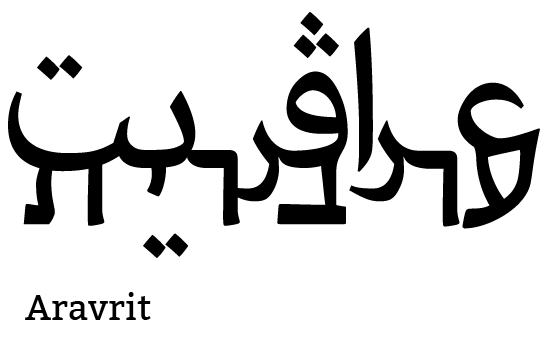About Aravrit
Aravrit is an experimental writing system presenting a set of hybrid letters merging Hebrew and Arabic. Each letter is composed of Arabic on the upper half and a Hebrew on the bottom half.
In Aravrit, one can read any chosen language, without ignoring the other one, which is always present.
عراڤريت نظام كتابة تجريبية مكوّن من دمج حروف عبرية وعربية مختلطة. يتألّف كل حرف من حرف عربي في القسم الأعلى وعبري في القسم الأسفل. مع عراڤريت يمكن للشخص قراءة اللغة الذي يريدها من دون تجاهل الأخرى لأنّها تبقى واضحة.
ערברית היא מערכת כתב נסיונית, המציגה אותיות היברידיות המשלבות עברית וערבית. כל אות מורכבת מערבית בחציה העליון ועברית בחציה התחתון.
בערברית, כל אחד יכול לקרוא את השפה שהוא בוחר, מבלי להתעלם מהשניה, שתמיד נוכחת.
Aravrit is a hybrid writing system, fusing Hebrew and Arabic letters to allow speakers of both languages to read the same words, simultaneously. In Aravrit, one can read either language without ignoring the other one, spreading a message of coexistence, compromise, and inclusion.
Aravrit, a Haifa-based project, spread across the globe and touched the lives of millions of people. Its unique approach to fostering dialogue between cultures resonated with public figures, cultural institutions, and underground movements. It has been featured in various international museums and media outlets ranging from the BBC to TEDx, the London Design Museum, the Light Festival in Jerusalem, SXSW, World Expo 2020 in Dubai, large-scale murals, and countless Schools, Universities, and communities in over 63 countries around the world. Notably, former Israeli President Reuven Rivlin invited Liron, the designer, to his residence to collaborate, present, and discuss the project.
The idea behind Aravrit was conceived by Liron Lavi Turkenich, a world-renowned typeface designer, when she walked down the streets of her hometown, Haifa, a mixed multicultural city in Israel where Jews, Christians, Muslims and Bahai live together. She noticed that when reading the bilingual street signs, she completely ignores the Arabic language written on them. This came as a revelation to Liron and manifested a deep societal issue in her country – communities living in parallel but never intersecting.
To explore this, Liron decided to study the neural mechanisms that allow our brain to read and understand letters. This inspired Liron to create a newly-formed writing system that merges the two ancient alphabets into hybrid letters, allowing readers of each language to read their own letters but this time, without ignoring the other.
The act of connecting two inherently conflicting languages – graphically and conceptually – into a hybrid typeface is a pivotal piece of ongoing work, enabling a new, a-politicized engagement between Hebrew and Arabic Speakers, rewiring our mindset to communicate differently, lighting up blind spots, and challenging the social norms.
Aravrit has changed the life of many in its decade of existence, gaining international acclaim and recognition for the mindset shift it sparks in those who encounter the work, encouraging people to think differently and closing gaps in a fractured world.
About the Founder and Creative Director

I’m Liron Lavi Turkenich, a multi-passionate typeface designer and a design entrepreneur based in Israel. Since graduating with an MA in Typeface Design from the University of Reading (UK), I have been designing custom multilingual typefaces and consulting for global companies specializing in Hebrew.
In addition to founding Aravrit, I’m doing many more things (which you are read about here).
I have several years of organizing, producing, and curating ATypI, an international typeface conference. I’m also co-running the Mentorship program on the international Alphabettes network. Additionally, I teach designers how to spread their work in workshops and consultations. I write on productivity, public speaking, and running multiple projects. Among my recent ventures was an illustrated Haggadah book for families, which received great reviews.
I love sharing my knowledge in talks and workshops, while not neglecting to search for the finest coffee and typographic treasures in dusty archives.


